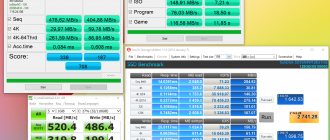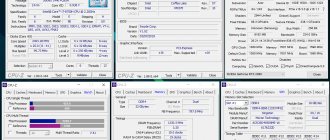Dell has introduced new portable computers of the G-Series family, positioned as gaming models for users with different income levels. The series includes laptops G3 15, G3 17, G5 15 and G7 15. All of them are equipped with eighth generation Intel Core processors. For the first three models, Core i5-8300HQ and Core i7-8750HQ chips are available, and for the fourth, a Core i9-8950HQ processor is also available. The amount of DDR4-2666 RAM can reach 32 GB. In this review, we will look at the Dell G5 15 5587, which is equipped with a Full HD screen, an NVIDIA GeForce GTX 1060 Max-Q graphics accelerator and an Intel Core i5-8300H processor. Data storage is provided by a 128 GB M.2 SSD and up to 1 TB HDD. As we can see from the characteristics of the Dell G5 15 5587, it can handle all existing computer games. It is worth noting that in this segment there are a lot of laptops with a similar configuration, so whether this laptop can compete with its opponents will depend on the attractiveness of the price.
Specifications
| CPU |
| Intel Core i5-8300H 2.3-4.0 GHz |
| RAM |
| 8 GB DDR4-2666 MHz |
| CD reader |
| No |
| Video card |
| NVIDIA GeForce GTX 1060 Max-Q(6GB GDDR5) |
| Display |
| 15.6 inches 16:9, 1920x 1080 pixels, LG D053F 156WF6, matte |
| HDD |
| HDD 1 TB WDC WD 10spzx-78Z10T1 (5400 rpm)+ SSD SK hynix SC311 M.2, 128 GB |
| operating system |
| Microsoft Windows 10 Home 64 Bit |
| Interfaces |
| 3 USB 3.0 / 3.1 Gen1, 1 USB 3.1 Gen2, 1 Thunderbolt, 1 HDMI, Network port, Audio: combined, Card Reader: SD |
| Connection |
| Killer e2400 Gigabit Ethernet Controller (10/100/1000MBit), Intel Wireless-AC 9560 (a/b/g/n/ac), Bluetooth 5.0 |
| Sound |
| 2 stereo speakers |
| Dimensions |
| 24.95 x 389 x 274.7 mm |
| weight |
| 2.83 kg |
| battery |
| 56 Wh |
| Price |
| — |
Review of Dell G5 15-5587 gaming laptop with Nvidia GeForce GTX 1060 graphics card
Although Dell has a separate Alienware brand for gaming laptops, Dell also produces gaming laptops under the Dell brand - in particular, the G series. In this review, we will look at one of these models: the 15-inch Dell G5 15-5587.
Options and packaging
The Dell G5 15-5587 laptop comes in a small and completely nondescript cardboard box, which is usually immediately thrown away.
In addition to a laptop and a quick user guide, the kit includes a power adapter.
Laptop configuration
There are quite a large number of different models of the Dell G5 15-5587 laptop. They can use different models of processors and video cards, different amounts of RAM. In addition, the data storage subsystem may be different. We tested a Dell G5 15-5587 laptop with the following configuration.
| Dell G5 15-5587 | ||
| CPU | Intel Core i7-8750H (Coffee Lake) | |
| Chipset | Intel HM370 | |
| RAM | 16 GB DDR4-2666 (2x8 GB) (Micron 8ATF1G64HZ-2G6E1) | |
| Video subsystem | Nvidia GeForce GTX 1060 (6 GB GDDR5) Intel HD Graphics 630 | |
| Screen | 15.6 inches, 1920x1080, IPS (AHVA) (AUO CV56F B156HAN) | |
| Sound subsystem | Realtek ALC256 | |
| Storage device | 1 × SSD 256 GB (M.2, SATA 6 Gb/s) (Toshiba KSG60ZMV256G) 1 × HDD 1 TB (SATA 6 Gb/s) (Seagate ST1000LM035-1RK172, 5400 rpm) | |
| Optical drive | No | |
| Card reader | SD/MMC | |
| Network interfaces | Wired network | Killer e2400 Gigabit Ethernet |
| WiFi | Intel Wireless-AC 9560 (802.11a/b/g/n/ac) | |
| Bluetooth | Bluetooth 4.1 | |
| Interfaces and ports | USB 3.0 | 3 (Type-A) |
| USB 2.0 | No | |
| Thunderbolt 3.0 | Type-C (USB 3.1 and DisplayPort) | |
| HDMI 2.0 | There is | |
| RJ-45 | There is | |
| Microphone input | yes (minijack, combined) | |
| Headphone output | yes (minijack, combined) | |
| Input Devices | Keyboard | with backlight and NumPad block |
| Touchpad | clickpad | |
| IP telephony | Webcam | There is |
| Microphone | There is | |
| Battery | lithium-ion, 56 Wh | |
| Dimensions | 389×275×25 mm | |
| Weight without power supply | 2.61 kg | |
| Power adapter | 180 W (19.5 V; 9.2 A) | |
| operating system | Windows 10 Home x64 | |
| Average price for this configuration | find out the price | |
| Retail offers for this configuration | find out the price | |
So, the basis of our Dell G5 15-5587 laptop is a six-core Intel Core i7-8750H processor. (Coffee Lake). It has a nominal clock speed of 2.2 GHz, which can be boosted up to 4.1 GHz in Turbo Boost mode. The processor supports Hyper-Threading technology. Its L3 cache size is 8 MB and its TDP is 45 W. This processor integrates the Intel HD Graphics 630 graphics core.
Depending on the laptop model, another processor of the Coffee Lake family may be installed - in particular, the quad-core Core i5-8300H.
Since we are talking about a gaming laptop, it comes with an Nvidia GeForce GTX 1060 discrete gaming graphics card with 6GB GDDR5. Moreover, a video card with Nvidia Max-Q technology is used.
Note that the laptop supports Nvidia Optimus technology, which is responsible for switching between discrete and processor graphics.
The base frequency of the Nvidia GeForce GTX 1060 (GP106) GPU is 1265 MHz, and in GPU Boost mode it can reach 1480 MHz.
In addition to the Nvidia GeForce GTX 1060 video card, the laptop can install Nvidia GeForce GTX 1050/Ti with 4 GB of video memory. Moreover, models with Nvidia GeForce GTX 1050/Ti video cards are equipped with a power adapter with a power of 130 W, and with a Nvidia GeForce GTX 1060 video card - with a power of 180 W.
In our case, the laptop was supposed to come with a 180 W power adapter, but for unknown reasons, a “junior” power supply was included in the package. The laptop turns on normally with it, but when booting, a warning appears that the power adapter is being used with insufficient power. So we initially tested the Dell G5 15-5587 with a 130 W power adapter, and only after that we received its “native” 180 W power adapter. Since the results of testing with a lower-power power adapter turned out to be very interesting, we decided to present them in the article too.
When using a 130W power adapter, the Nvidia GeForce GTX 1060 graphics card did not perform as well as it should in the Dell G5 15-5587 laptop, including very low results in gaming tests. According to the GPU-Z utility, the graphics processor and memory in this case operate under load at the following frequencies:
When using the “correct” 180W power adapter, the results change dramatically:
There are two slots for installing SO-DIMM memory modules in the laptop.
In our case, the laptop had two DDR4-2666 memory modules (Micron 8ATF1G64HZ-2G6E1) with a capacity of 8 GB installed. The total memory capacity was 16 GB, and, naturally, the memory operated in dual-channel mode.
The maximum amount of memory that can be installed in a laptop is 32 GB.
As for the data storage subsystem, there are options. In our case, we installed a Toshiba KSG60ZMV256G SSD with a capacity of 256 GB (M.2, SATA 6 Gbit/s) and a 2.5-inch Seagate ST1000LM035-1RK172 HDD (1 TB, SATA 6 Gbit/s, 5400 rpm min).
In the maximum configuration, the laptop can be equipped with a NVMe SSD drive with a PCIe 3.0 x4 interface with a capacity of 512 GB.
There is no optical drive in the laptop, which is welcome.
The communication capabilities of the laptop are determined by the presence of the Intel Wireless-AC 9560 wireless network adapter. This module supports the 2.4 and 5 GHz frequency ranges and complies with IEEE 802.11b/g/n/ac specifications. At the same time, the Bluetooth 4.1 interface is also implemented.
In addition, the laptop also has a wired gigabit network interface based on the Killer e2400 Gigabit Ethernet controller.
The audio subsystem of the Dell G5 15-5587 laptop includes two speakers, and the audio path is based on the Realtek ALC256 codec.
The laptop is equipped with a non-removable battery with a capacity of 56 Wh.
The laptop also has a built-in webcam with HD resolution (720p) and a bi-directional digital microphone.
Appearance and ergonomics of the case
The design of the Dell G5 15-5587 laptop is very bright and original.
The laptop body is made of magnesium alloy and plastic. The surface of the lid and the side ends of the case are painted bright red and have a soft-touch coating. Typically, a soft-touch coating is very easily soiled, but on the Dell G5 15-5587 laptop this surface, on the contrary, is resistant to fingerprints. The Dell logo is emblazoned on the lid of the laptop.
The bottom panel of the laptop case is made of traditional black plastic. This panel has ventilation slots and rubber strips to ensure the laptop remains stable on a horizontal surface.
The frame around the screen is also made of matte black plastic. The frame thickness is 21 mm on the sides, 19 mm on the top, and 30 mm on the bottom. At the bottom of the frame there is the inscription “Dell”.
On the frame at the top of the screen, in the center, there is a webcam, as well as microphone holes.
The keyboard on this laptop is black. But we will tell you in detail about it, as well as about the touchpad, a little later. The working surface framing the keyboard and touchpad is made of dark gray plastic with a silver tint. It is resistant to hand marks, so this is a rare case when the surface is both stylish and practical.
The power button is located in the upper right corner above the keyboard.
There is only one LED laptop status indicator in this model; it is located in the center of the front edge of the case. By default, this is the power and battery charge indicator. This indicator turns white when the power adapter is connected and the battery charge is more than 5%. If the indicator lights up yellow, then the power adapter is connected, but the battery charge is less than 5%. If the indicator is not lit, this means that either the power adapter is connected and the battery is fully charged, or the laptop is running on battery power and the battery charge is more than 5%. It could also mean that the laptop is in standby, hibernation, or turned off.
Another interesting feature of the indicator is that it can be switched to drive activity mode by pressing the Fn+H key combination.
The system for attaching the cover to the body is a single hinge, which is located at the bottom of the screen. This mounting system allows you to tilt the screen relative to the keyboard plane at an angle of 120 degrees.
The laptop lid is 7 mm thick. It is quite rigid and almost does not bend when you press on the screen, but the hinge system for attaching it to the body does not provide sufficient bending strength.
On the left side of the laptop body there is a Noble lock connector, a USB 3.0 port with support for PowerShare technology, an RJ-45 network connector, a memory card slot and a power connector.
On the right side of the case there are two more USB 3.0 ports, a combined audio jack, an HDMI 2.0 video output, as well as a Thunderbolt 3.0 port (Type-C connector) with support for USB 3.1 and DisplayPort 1.2.
Disassembly capabilities
The Dell Inspiron G5 15-5587 laptop can be partially disassembled, and on the Dell website there are detailed instructions (in Russian) on exactly how to disassemble it. By removing the bottom panel of the laptop, you can gain access to the HDD and SSD, memory modules, Wi-Fi module, battery and cooling system.
Input Devices
Keyboard
The Dell G5 15-5587 laptop uses a membrane-type keyboard with increased distance between the keys. The size of the keys is 15x15 mm, and the distance between them is 3.5 mm. The pressing depth (key stroke) is 1 mm.
The key pressing force is 72 g, and the key release occurs with a residual force of 25 g.
The base under the keyboard is very rigid; it does not flex when typing. The key travel is slightly spring-loaded, with easy press retention. Overall the keyboard is very comfortable.
The keyboard in the laptop has a two-level backlight, which is controlled using function keys. If you do not press the keys for a long time, the backlight turns off, but as soon as you press any key, it turns on again.
The top row of keys, as usual, has two functions: either traditional F1-F12, or laptop control functions, one set works directly, the second - in combination with the Fn function key.
Touchpad
The Dell G5 15-5587 laptop uses a clickpad with simulated key presses. The dimensions of its working area are 107x80 mm, which is quite enough for comfortable work.
The touch surface of the touchpad is slightly recessed and framed by a red border.
Sound path
As already noted, the audio subsystem of the Dell G5 15-5587 laptop is based on the Realtek ALC256 HDA codec, and the laptop case has two speakers.
According to subjective feelings, the acoustics in this laptop are very good. The maximum volume level is quite sufficient, and there is no rattling.
Traditionally, to evaluate the output audio path intended for connecting headphones or external speakers, we conduct testing using an external Creative E-MU 0204 USB sound card and the RightMark Audio Analyzer 6.3.0 utility. Testing was carried out in stereo mode, 24-bit/44 kHz. According to the test results, the audio path received an “Excellent” rating.
Test results in RightMark Audio Analyzer 6.3.0
| Device under test | Laptop Dell Inspiron G5 15-5587 |
| Operating mode | 24-bit, 44 kHz |
| Signal route | headphone output - Creative E-MU 0204 USB input |
| RMAA version | 6.3.0 |
| Filter 20 Hz - 20 kHz | Yes |
| Signal normalization | Yes |
| Level change | −0.9 dB / −0.9 dB |
| Mono mode | No |
| Calibration signal frequency, Hz | 1000 |
| Polarity | correct/correct |
General results
| Frequency response unevenness (in the range 40 Hz - 15 kHz), dB | +0,01, −0,07 | Great |
| Noise level, dB (A) | −91,6 | Very good |
| Dynamic range, dB (A) | 91,5 | Very good |
| Harmonic distortion, % | 0,0027 | Great |
| Harmonic distortion + noise, dB (A) | −84,0 | Fine |
| Intermodulation distortion + noise, % | 0,0075 | Great |
| Interpenetration of channels, dB | −92,4 | Great |
| Intermodulation at 10 kHz, % | 0,0072 | Great |
| Overall rating | Great | |
Frequency response
| Left | Right | |
| 20 Hz to 20 kHz, dB | −0,92, +0,01 | −0,91, +0,02 |
| 40 Hz to 15 kHz, dB | −0,07, +0,01 | −0,04, +0,02 |
Noise level
| Left | Right | |
| RMS power, dB | −90,8 | −91,0 |
| RMS Power, dB(A) | −91,5 | −91,7 |
| Peak level, dB | −76,0 | −76,1 |
| DC offset, % | −0,0 | +0,0 |
Dynamic range
| Left | Right | |
| Dynamic range, dB | +90,8 | +90,9 |
| Dynamic range, dB (A) | +91,5 | +91,6 |
| DC offset, % | +0,00 | −0,00 |
Harmonic distortion + noise (−3 dB)
| Left | Right | |
| Harmonic distortion, % | +0,0022 | +0,0032 |
| Harmonic distortion + noise, % | +0,0063 | +0,0067 |
| Harmonic distortion + noise (A-weighted), % | +0,0060 | +0,0067 |
Intermodulation distortion
| Left | Right | |
| Intermodulation distortion + noise, % | +0,0076 | +0,0075 |
| Intermodulation distortion + noise (A-weighted), % | +0,0067 | +0,0066 |
Interpenetration of stereo channels
| Left | Right | |
| Penetration at 100 Hz, dB | −86 | −84 |
| Penetration at 1000 Hz, dB | −92 | −91 |
| Penetration at 10000 Hz, dB | −90 | −89 |
Intermodulation distortion (variable frequency)
| Left | Right | |
| Intermodulation distortion + noise at 5000 Hz, % | 0,0071 | 0,0073 |
| Intermodulation distortion + noise at 10000 Hz, % | 0,0072 | 0,0072 |
| Intermodulation distortion + noise at 15000 Hz, % | 0,0073 | 0,0073 |
Screen
The Dell G5 15-5587 laptop uses an AU Optronics CV56F B156HAN IPS matrix with LED backlighting based on white LEDs. It has a matte anti-reflective finish and measures 15.6 inches diagonally. The screen resolution is 1920×1080 pixels.
According to measurements, the matrix in this laptop does not flicker over the entire range of brightness levels. The maximum brightness level on a white background is 212 cd/m², and the minimum brightness level on a white background is 13 cd/m². At maximum screen brightness, the gamma value is 2.55
| Maximum white brightness | 212 cd/m² |
| Minimum white brightness | 13 cd/m² |
| Gamma | 2,55 |
The LCD color gamut of the Dell G5 15-5587 covers 59.2% of sRGB and 41.3% of Adobe RGB, and the color gamut is 60.0% of sRGB and 41.3% of Adobe RGB. By today's standards, this is an average result.
The filters of the LCD matrix slightly mix the components with each other. So, green is mixed into the red spectrum, but the blue spectrum is well isolated. This situation is quite typical for LCD matrices used in laptops.
The color temperature of the LCD screen of the Dell G5 15-5587 laptop is stable across the entire gray scale (dark areas can be ignored due to measurement error) and is approximately 6200 K.
The stability of color temperature is due to the fact that the primary colors are well balanced across the entire gray scale.
As for color rendering accuracy (delta E), its value does not exceed 3.5 (the dark area can be ignored), which is a good result for this class of screens.
Screen viewing angles (both horizontal and vertical) are very wide. When looking at the image at an angle horizontally and vertically, the color is almost not distorted.
Overall, the screen in the Dell G5 15-5587 laptop can be assessed as satisfactory, it has wide viewing angles and a matte finish. But there are also disadvantages: not very high brightness and not very wide color gamut.
Working under load
As we have already noted, the Dell G5 15-5587 laptop uses a six-core Intel Core i7-8750H processor. To load the processor, the AIDA64 and Prime95 utilities (Small FFT test) were used, and monitoring was carried out using the AIDA64 and CPU-Z utilities.
In high processor load mode (Stress CPU test from the AIDA64 package), the clock frequency of the processor cores is 3.4 GHz. The core temperature in this mode is approximately 75 °C, and the power consumption is 45 W.
In extreme processor load mode (Prime95 test), the core frequency already drops to 2.3 GHz.
The temperature of the processor cores in this mode does not exceed 71 °C, and the power consumption is the same 45 W.
The results presented clearly demonstrate that the Dell G5 15-5587 has a fairly effective cooling system: the laptop does not overheat at any processor load level.
If both the processor (Prime95) and the video card (FurMark) are simultaneously loaded in stress mode, then the frequency of the processor cores is 2.6 GHz,
The temperature of the processor cores in this mode does not exceed 78 °C, and the power consumption is again 45 W.
Drive performance
As already noted, the laptop's storage subsystem is a Toshiba KSG60ZMV256G SSD drive with a capacity of 256 GB (M.2, SATA 6 Gbit/s) and a 2.5-inch Seagate ST1000LM035-1RK172 HDD (1 TB, SATA 6 Gbit/s s, 5400 rpm). Of interest, first of all, is the performance of the SSD, which is a system drive.
The ATTO Disk Benchmark 4.00 utility determines its maximum sequential read speed at 500 MB/s and sequential write speed at 330 MB/s. For an SSD drive with a SATA interface, this is a quite typical result.
The CrystalDiskMark 6.0.1 utility demonstrates approximately similar results.
And to complete the picture, we will also present the results of the Anvil's Storage Utilities 1.10 test.
Noise level
The cooling system in the Dell G5 15-5587 laptop consists of two coolers (one for the processor and one for the video card).
To measure the noise level generated by a laptop, we used a special sound-absorbing chamber, and a sensitive microphone was positioned relative to the laptop to simulate the typical position of the user's head.
The noise level in idle mode is 20 dBA. At this noise level, it is very difficult to hear the laptop.
In stress CPU load mode (Prime95 utility, Small FFT test), the noise level is 30 dBA. This is not much, at this level of noise the laptop will be noticeable in a typical living room, but it will not cause any irritation.
In stress loading mode of the video card (FurMark utility), the noise level is 40 dBA. This is a lot, the noise level reaches the ergonomic limit. In this mode, the laptop will be frankly noisy and stand out from all other devices even in a typical office space, not to mention a quiet apartment.
In the mode of simultaneous stress loading of the processor and video card, the noise level is again 40 dBA.
| Load scenario | Noise level |
| Idle mode | 20 dBA |
| CPU stress | 30 dBA |
| Stressful loading of the video card | 40 dBA |
| Stressful CPU and GPU usage | 40 dBA |
In general, we can say that the Dell G5 15-5587 laptop is average in terms of noise level.
Battery life
We measured the operating time of the Dell G5 15-5587 laptop in offline mode using our method using the iXBT Battery Benchmark v1.0 script. Let us remind you that we measure battery life at screen brightness of 100 cd/m². When testing battery life, the processor graphics core was used (as it is more economical). The test results are presented in the table:
| Load scenario | Working hours |
| Watch video | 6 hours 03 minutes |
| Working with text and viewing photos | 9 hours 50 minutes |
For a gaming laptop, this is very serious battery life. You can even talk about the record-breaking autonomy of the Dell G5 15-5587 (again, within the class of gaming laptops).
Performance Research
To evaluate the performance of the Dell G5 15-5587 laptop, we used our new performance measurement methodology using the iXBT Application Benchmark 2020, as well as the iXBT Game Benchmark 2020.
The testing results in the iXBT Application Benchmark 2018 package are shown in the table. During testing, a 130 W power adapter was used (instead of 180 W) with a fully charged battery. The results are calculated from five runs of each test with a confidence level of 95%.
For greater clarity, we also present results for the Alienware A15 R4 laptop based on the Intel Core i9-8950HK processor and Nvidia GeForce GTX 1080 graphics card. For the Alienware A15 R4 laptop, the results are shown without overclocking the processor.
| Test | Reference result | Alienware A15 R4 (non-overclocked) | Dell Inspiron G5 15-5587 |
| Video conversion, points | 100 | 61,2±0,6 | 64,0±0,6 |
| MediaCoder x64 0.8.52, c | 96,0±0,5 | 159,0±0,5 | 145±4 |
| HandBrake 1.0.7, c | 119,31±0,13 | 196,1±1,2 | 182,3±1,2 |
| VidCoder 2.63, c | 137,22±0,17 | 210±7 | 227,0±0,3 |
| Rendering, points | 100 | 63,9±1,0 | 67,0±0,8 |
| POV-Ray 3.7, c | 79,09±0,09 | 126±7 | 116,0±2,6 |
| LuxRender 1.6 x64 OpenCL, c | 143,90±0,20 | 235,0±2,5 | 216,0±0,5 |
| Blender 2.79, c | 105,13±0,25 | 170,8±0,9 | 164,5±1,4 |
| Adobe Photoshop CC 2020 (3D rendering), c | 104,3±1,4 | 148±3 | 150±6 |
| Video content creation, points | 100 | 72,0±0,4 | 73,0±0,2 |
| Adobe Premiere Pro CC 2020, c | 301,1±0,4 | 337±5 | 349,19±0,13 |
| Magix Vegas Pro 15, c | 171,5±0,5 | 264±5 | 263,0±0,5 |
| Magix Movie Edit Pro 2020 Premium v.16.01.25, c | 337,0±1,0 | 536±4 | 517,0±2,4 |
| Adobe After Effects CC 2020, c | 343,5±0,7 | 478,7±1,5 | 476±4 |
| Photodex ProShow Producer 9.0.3782, c | 175,4±0,7 | 237±4 | 224,1±1,3 |
| Digital photo processing, points | 100 | 134,0±1,6 | 96,4±0,4 |
| Adobe Photoshop CC 2020, c | 832,0±0,8 | 862±10 | 976±10 |
| Adobe Photoshop Lightroom Classic CC 2020, c | 149,1±0,7 | 164,5±1,8 | 179,4±0,8 |
| Phase One Capture One Pro v.10.2.0.74, c | 437,4±0,5 | 159±5 | 345,6±2,1 |
| Text recognition, points | 100 | 60,9±2,5 | 64,1±0,3 |
| Abbyy FineReader 14 Enterprise, c | 305,7±0,5 | 502±20 | 476,0±2,2 |
| Archiving, points | 100 | 79,7±0,4 | 77,1±0,4 |
| WinRAR 5.50 (64-bit), c | 323,4±0,6 | 411±4 | 425±5 |
| 7-Zip 18, c | 287,50±0,20 | 356,2±0,7 | 368±0,2 |
| Scientific calculations, points | 100 | 72,0±1,4 | 75,5±0,8 |
| LAMMPS 64-bit, c | 255,0±1,4 | 349±10 | 334±4 |
| NAMD 2.11, c | 136,4±0,7 | 218±4 | 199,6±2,1 |
| Mathworks Matlab R2017b, c | 76,0±1,1 | 110±6 | 103,9±2,5 |
| Dassault SolidWorks Premium Edition 2020 SP4.2 with Flow Simulation 2020, c | 129,1±1,4 | 152±6 | 151±5 |
| File operations, points | 100 | 254±13 | 64,4±1,3 |
| WinRAR 5.50 (Store), c | 86,2±0,8 | 35,7±1,1 | 137±5 |
| Data copying speed, s | 42,8±0,5 | 16,1±1,5 | 64,9±0,5 |
| Integral result excluding storage, points | 100 | 74,9±0,5 | 73,2±0,2 |
| Integral result Storage, points | 100 | 254±13 | 64,4±1,3 |
| Integral performance result, points | 100 | 107,7±1,7 | 70,4±0,4 |
Based on the integral result without taking into account the drive, the Dell G5 15-5587 laptop based on the Core i7-8750H processor demonstrates almost the same level of performance as the Alienware 15 R4 laptop based on the Intel Core i9-8950HK processor. This at least means that in non-gaming applications, where the main load falls on the processor and the video accelerator is almost always asleep, the adapter's power of 130 W is quite enough.
In tests, the result of which is determined by the performance of the system drive, the Dell G5 15-5587 is, of course, inferior to the Alienware 15 R4 laptop with a high-speed NVMe SSD drive. Accordingly, in terms of the overall integrated performance indicator, the Dell G5 15-5587 is inferior to the Alienware 15 R4 laptop.
However, the Dell G5 15-5587 laptop can easily be classified as a productivity device. According to our grading, with an integral performance result of less than 45 points, we classify devices as entry-level performance, with a result in the range from 46 to 60 points - into the category of medium-level performance devices, with a result from 60 to 75 points - into the category of productive devices, and a result of more than 75 points is already a category of high-performance solutions.
Now let's look at the results of testing the Dell G5 15-5587 in games.
Testing was carried out at a resolution of 1920x1080 in game settings for maximum, medium and minimum quality. When testing in games, we used an Nvidia GeForce GTX 1060 video card with video driver version ForceWare 398.82 (in the video driver settings, the use of a high-performance graphics processor was specified in order to exclude the possibility of switching to the processor graphics core).
From the very beginning, we assumed that the adapter's 130 W power might not be enough for games, and testing only confirmed our fears. The results obtained are not typical for the Nvidia GeForce GTX 1060 video card and rather demonstrate how important it is that the power adapter provides the power necessary for a given laptop configuration. That is why the results obtained cannot be considered as a demonstration of the gaming capabilities of the laptop. This is just a demonstration of how insufficient power adapter power can affect the performance of a laptop.
The test results when powering the laptop from a 130 W power adapter are as follows:
| Game tests | Maximum quality | Medium quality | Minimum quality |
| World of Tanks | 16±3 | 36±2 | 220±1 |
| F1 2017 | 20±3 | 49±2 | 60±2 |
| Far Cry 5 | 18±3 | 22±3 | 26±5 |
| Total War: Warhammer II | 3±1 | 12±3 | 16±3 |
| Tom Clancy's Ghost Recon Wildlands | 11±1 | 20±1 | 32±1 |
| Final Fantasy XV | 11±2 | 12±2 | 20±3 |
| Hitman | 14±3 | 33±2 | 42±2 |
Out of interest, we repeated the testing when the laptop was disconnected from the power supply, that is, when powered by a pre-charged battery. The test results were as follows:
| Game tests | Maximum quality | Medium quality | Minimum quality |
| World of Tanks | 25±2 | 64±7 | 277±4 |
| F1 2017 | 24±3 | 29±3 | 31±3 |
| Far Cry 5 | 19±5 | 23±2 | 27±3 |
| Total War: Warhammer II | 5±1 | 24±3 | 25±3 |
| Tom Clancy's Ghost Recon Wildlands | 12±1 | 21±1 | 29±3 |
| Final Fantasy XV | 15±2 | 19±2 | 24±1 |
| Hitman | 21±3 | 35±3 | 44±3 |
Finally, the test results when powered by a 180 W adapter, that is, in normal, standard mode, are as follows:
| Game tests | Maximum quality | Medium quality | Minimum quality |
| World of Tanks | 94±2 | 246±5 | 572±6 |
| F1 2017 | 79±3 | 161±4 | 191±4 |
| Far Cry 5 | 61±2 | 72±2 | 85±4 |
| Total War: Warhammer II | 19±1 | 76±3 | 95±3 |
| Tom Clancy's Ghost Recon Wildlands | 36±1 | 62±1 | 86±3 |
| Final Fantasy XV | 43±2 | 58±3 | 78±2 |
| Hitman | 66±3 | 93±3 | 102±3 |
As you can see, when using the “native” power adapter, the results are as they should be. At a resolution of 1920x1080, you can comfortably (with an FPS of more than 40) play all games without exception at medium quality settings, and even with maximum quality settings you can comfortably play the vast majority of games.
Overall, we can say that this is a productive gaming laptop.
conclusions
So, we looked at the Dell G5 15-5587 laptop based on the Core i7-8750H processor and Nvidia GeForce GTX 1060 video card.
The laptop is very decent. It has an excellent, bright design, a very practical body surface that does not leave hand marks, a good screen, an excellent audio system, a comfortable keyboard and touchpad, a high level of performance, including in games, and a very long battery life.
And the most important thing is that such a laptop costs even a little less than 100 thousand rubles, which can be considered a completely adequate and even attractive price.
In conclusion, we suggest watching our video review of the Dell G5 15-5587 laptop:
You can also watch our video review of the Dell G5 15-5587 laptop on iXBT.Video











